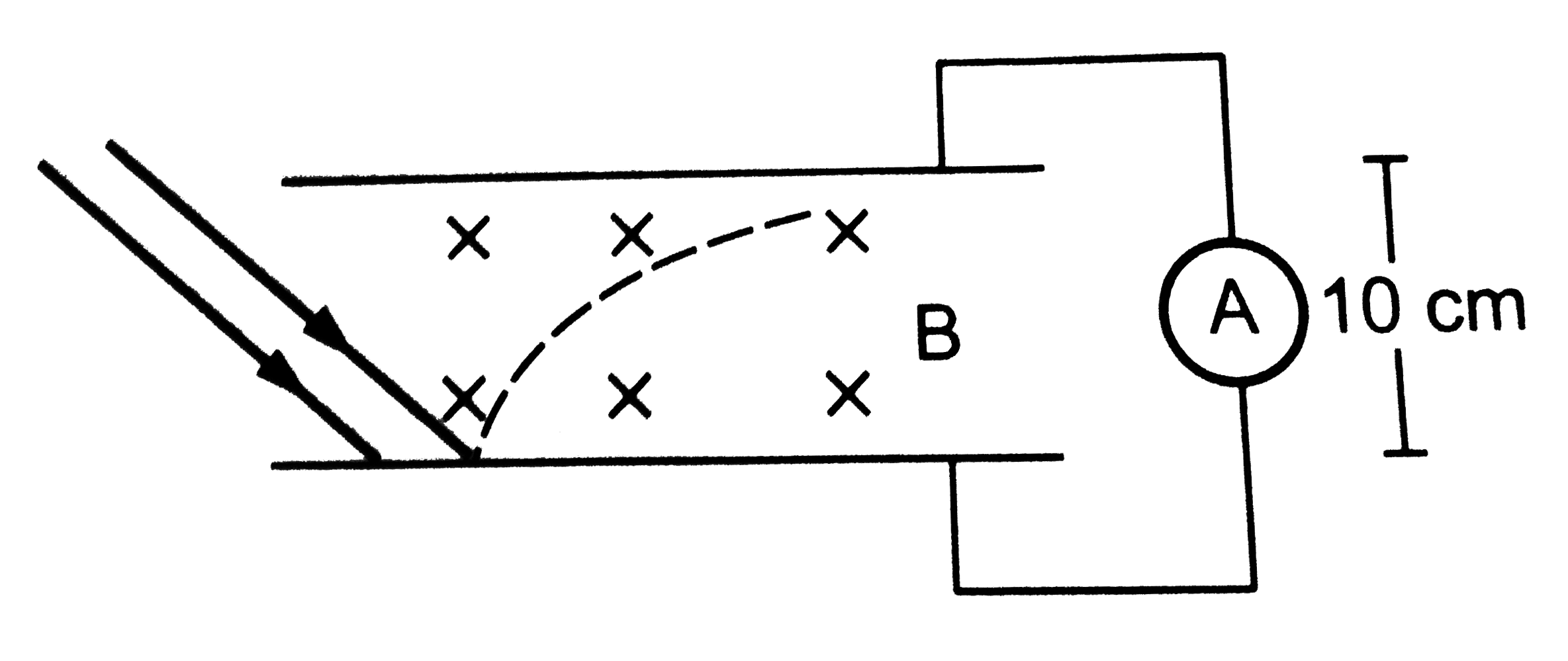Two metallic plates P (collector) and Q (emitter) are separated by a distance of 0.10 meter. These are connected through an ammeter without any cell. A magnetic field B exists parallel to the plates. Light of wavelength between 4000Åand6000Å fall on the plate whose work function is 2.39eV. Calculate the minimum value of B for which the current registered with ammeter is zero. Use, h=6.6×10−34Js,e=1.6×10−19C
Energy of the incident photon of light of wave length 6000Å is
E=hcλ=(6.6×10−34)×(3×108)6000×1.6×10−19eV=2.01eV
Since this value of energy is less than work function (=2.39eV) of the metal, hence no photoelectron is emitted for light of wavelength 6000Å Since the energy of photon of light of wavelength 4000Å is greater than 2.39 eV , so photoelectric emission takes place with its helt.
Maximum K.E. of the emitted photoelectron is
Kmax=12mv2max=hcλ−ϕ0=(6.6×10−34)×(3×108)4000×10−10×1.6×10−19−2.39eV
=3.1−2.39=0.71eV=0.71×1.6×10−19J
vmax=[2×0.71×1.6×10−199.1×10−31]1/2=5×105m/s
For zero constantl, mv2r=evBorB=mver=(9.1×10−31)×5×105(1.6×10−19)×0.1=2.86×10−5T
Related Playlists
- BOOK - PRADEEPCHAPTER - DUAL NATURE OF RADIATION AND MATTEREXERCISE - Value based question1videos
DUAL NATURE OF RADIATION AND MATTER
- BOOK - PRADEEPCHAPTER - DUAL NATURE OF RADIATION AND MATTEREXERCISE - Exercise191videos
DUAL NATURE OF RADIATION AND MATTER
- BOOK - PRADEEPCHAPTER - DUAL NATURE OF RADIATION AND MATTEREXERCISE - Long answer1videos
DUAL NATURE OF RADIATION AND MATTER
- BOOK - PRADEEPCHAPTER - CURRENT ELECTRICITYEXERCISE - Problems for Practice (B)2videos
CURRENT ELECTRICITY
- BOOK - PRADEEPCHAPTER - ELECTROMAGNETIC INDUCTION & ALTERNATING CURRENTEXERCISE - Multiple Choice Questions1videos
ELECTROMAGNETIC INDUCTION & ALTERNATING CURRENT
Similar Questions
Two metallic plates P(collector) and Q (emitter) are separated by a distance of 0.2 m. These are connected through an 0.2 m. These are connected through an ammeter without any cell. A magnetic field B exists parallel to the plates. Light of wavelengths between 2000 Å and 3000 Å fall of the plate Q whose work function is 2.22 eV.
The minimum value of B for which the current registered with ammeter is zero, isView SolutionIn an experiment on photoelectric effect, the emitter and the collector plates are placed at a separation of 10cm and are connected through an ammeter without any cell.

A magnetic field B exists parallel to the plates. The work function of the emitter is 2.39 e V and the light incident on it has wavelengths between 400nm and 600nm. Find the minimum value of B for which the current registered by the ammeter is zero. Neglect any effect of space charge.View SolutionIn an experiment on photoelectric effect, the emitter and the collector plates are placed at a separation of 10cm and are connected through an ammeter without any cell. A magnetic field B exists parallel to the plates. The work function of the emitter is 2.39 e V and the light incident on it has wavelengths between 400nm and 600nm. Find the minimum value of B for which the current registered by the ammeter is zero. Neglect any effect of space charge.
 View Solution
View SolutionIn a photocell the plates P and Q have a separation of 5 cm, which are connected through a galvanometer without any cell. Bichromatic light of wavelengths 4000Å and 6000Å are incidenton plate Q whose work- functionis 2.39 eV. If a uniform magnetic field B exists parallel to the plates, find the minimum value of B for which the galvanometer shows zero deflection.
View SolutionIn a photocell the plates P and Q have a separation of 5 cm, which are connected through a galvanometer without any cell. Bichromatic light of wavelengths 4000Å and 6000Å are incidenton plate Q whose work- functionis 2.39 eV. If a uniform magnetic field B exists parallel to the plates, find the minimum value of B for which the galvanometer shows zero deflection.
View SolutionA radiation of wave length 2500A0 is incident on a metal plate whose work function is 3.5eV. Then the potential required to stop the fastest photo electrons emitted by the surface is (h=6.63×10−34Js&c=3×108m/s)
View SolutionLight of wavelength 4000Å is allowed to fall on a metal surface having work function 2 eV. The maximum velocity of the emitted electrons is
(h=6.6×10−34Js)View SolutionLight of wavelength 4000Å is allowed to fall on a metal surface having work function 2 eV. The maximum velocity of the emitted electrons is
(h=6.6×10−34Js)View SolutionLight of wavelength 5000Å falls on a metal surface of work function 1.9eV. Find (i) the energy of photons in eV (ii) the kinetic energy of photoelectrons and (iii) the stopping potential. Use h=6.63×10−34Js,
c=3×108ms−1,e=1.6×10−9C.View SolutionA light of wavelength 5000Å falls on a photosensitive plate with photoelectric work function 1.90 eV. Kinetic energy of the emitted photoelectrons will be (h=6.63×10−34J.s)
View Solution

